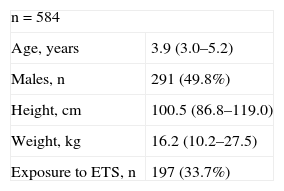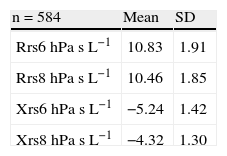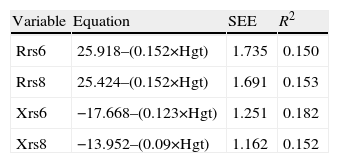Recently, multi-ethnic reference ranges for spirometry have been created for use worldwide. In comparison, forced oscillation technique (FOT) reference values are limited to specific equipment and study populations, with current FOT reference ranges created in a Caucasian population. We aimed to develop FOT reference ranges for preschool-aged Mexican children and to compare these with current FOT reference ranges.
Patients and methodsRespiratory resistance (Rrs) and reactance (Xrs) were measured in healthy Mexican children three to five years of age using commercial FOT equipment. The relationship between height and Rrs and Xrs was determined using regression analyses, taking into account age, weight, sex, and exposure to tobacco smoke. Reference equations were calculated for the Mexican children and Z-scores determined for Rrs and Xrs at 6 and 8Hz. A paired t-test assessed the difference in Z-scores between the Australian reference values and those created for the Mexican cohort.
ResultsFOT was successfully measured in 584children. Height was a significant predictor of Rrs and Xrs at 6 and 8Hz (P<.05). Z-scores calculated using the Australian reference equations overestimated lung function in Mexican children for both Rrs and Xrs at 6 and 8Hz (P<.001).
ConclusionThe development of FOT reference ranges specific to Mexican preschool-aged children will allow for the correct interpretation of FOT measurements. This study also showed that current FOT reference ranges overestimate lung function in Mexican children. The importance of using ethnic appropriate reference ranges for interpreting lung function is highlighted.
Recientemente se han establecido rangos de referencia multiétnicos de los valores de la espirometría para un uso en todo el mundo. Comparativamente, los valores de referencia de la técnica de oscilación forzada (TOF) se limitan a un equipamiento específico y unas poblaciones de estudio concretas, con los rangos de referencia actualmente disponibles que se elaboraron en una población caucásica. Nuestro objetivo fue establecer rangos de referencia de la TOF en niños en edad preescolar mexicanos y compararlos con los rangos de referencia actuales de la TOF.
Pacientes y métodosSe efectuaron determinaciones de la resistencia respiratoria (Rrs) y de la reactancia (Xrs) en niños mexicanos sanos de entre 3 y 5años de edad, con el empleo de un equipo de TOF comercializado. Se determinó la relación entre la altura y los valores de Rrs y Xrs mediante el empleo de un análisis de regresión, teniendo en cuenta la edad, el peso, el sexo y la exposición a humo de tabaco. Se calcularon las ecuaciones de referencia para los niños mexicanos y se determinaron las puntuaciones Z para Rrs y Xrs a 6 y 8Hz. Se utilizó una prueba de t para evaluar la diferencia de las puntuaciones Z entre los valores de referencia australianos y los establecidos en la cohorte mexicana.
ResultadosSe determinó satisfactoriamente la TOF en un total de 584niños. La altura fue un factor predictivo significativo de la Rrs y la Xrs a 6 y 8Hz (p<0,05). Las puntuaciones Z calculadas con el empleo de las ecuaciones de referencia australianas sobrevaloraron la función pulmonar en los niños mexicanos tanto para la Rrs como para la Xrs a 6 y 8Hz (p<0,001).
ConclusiónEl desarrollo de rangos de referencia de la TOF específicos para los niños de edad preescolar mexicanos permitirá una interpretación correcta de las determinaciones de la TOF. Este estudio puso de relieve también que los rangos de referencia actuales de la TOF sobrevaloran la función pulmonar en los niños mexicanos. Esto resalta la importancia de utilizar rangos de referencia apropiados al origen étnico para interpretar la función pulmonar.
The forced oscillation technique (FOT) is a useful instrument for evaluating the lung mechanics in various respiratory diseases.2,3 It requires minimal cooperation, which makes it very attractive for use in preschool children. The American Thoracic Society (ATS) and European Respiratory Society (ERS) 2007 statement4 on the FOT in preschool children provides recommendations for standardising the methodology and equipment used for FOT, and encourages the establishment of reliable reference ranges.
Current FOT reference ranges are specific for the type of equipment used (signal or impulse oscillometry [IOS], which forces a pseudo-random noise) and for the geographical or ethnic characteristics of the population in which they were established. This limits the clinical usefulness of the FOT, unlike spirometry, in which reference ranges that take into account the various ethnic groups have been established. As far as we know, there are currently no FOT reference ranges specific for Mexican preschool children using commercial FOT equipment. This lack of appropriate FOT reference ranges that are specific for the Mexican population limits the application of this technique in this group.
The aim of this study was to provide normal reference data for respiratory resistance (Rrs) and reactance (Xrs), measured using commercial FOT equipment, for use in Mexican preschool children. Our objective was also to determine whether the FOT reference ranges created in a population of Australian preschool children were applicable to a Mexican population of the same age, using the same commercial equipment.
MethodsStudy ParticipantsChildren were recruited in the prenatal period as part of a study on omega-3 polyunsaturated fatty acid supplementation and allergic diseases in childhood.5 Women were recruited at the Mexican Institute of Social Security (Instituto Mexicano del Seguridad Social [IMSS]) General Hospital and at three small clinics in Cuernavaca (Mexico). Possible participation was proposed to women who attended prenatal care visits (gestation week 18–22), were aged 18–35 years, planned to breastfeed and did not take fish oil or omega-3 fatty acid supplements during the pregnancy. Women who come to these health centres are broadly representative of a population of average or low socioeconomic level, and either they or their partner are employed. The study was a double-blind, randomised, placebo-controlled clinical trial, in which pregnant women received omega-3 fatty acid supplements or a placebo from gestation week 22 until parturition. The clinical results were evaluated in the children, from birth to 5 years of age. Continuous evaluation of exposure to environmental tobacco smoke (ETS) was carried out at the scheduled visits, using a questionnaire administered to the mothers. This study was approved the Emory University internal review board and the National Institute for Public Health biosafety and ethics committees. Written consent was obtained from the mother for participation in the study.
Forced Oscillation Technique MeasurementPulmonary function measurements using the FOT were attempted in children over the age of three. All children had been free from respiratory symptoms and infections in the two weeks prior to the FOT measurements. All Rrs and Xrs measurements were performed with a commercial device (I2M; Chess Medical, Belgium, marketed in Italy by Cosmed), applying ERS recommendations.4 The device was calibrated daily using a known resistance. Children were asked to breathe through a mouthpiece that incorporated a bacterial filter (Cosmed, Italy) and was connected to the device. This article presents only a brief explanation of the FOT methodology; for a detailed explanation, the reader is referred to previous publications.1 A signal was applied to force a pseudo-random noise from the device to the child's mouth at frequencies of between 4 and 8Hz. The measurements were taken with the child seated in an upright position, with their head in a neutral position. The child was instructed to breathe normally with a noseclip in place while a technician supported the cheeks and lower jaw. Each measurement period lasted eight seconds, after which the child could rest by removing the mouthpiece or they could continue with a new measurement.
Measurements in which the following were observed were excluded from the analysis: irregular or rapid breathing, swallowing, incomplete seal around the mouthpiece (leak), movement of the mouth, tongue or head, glottal closure, talking or audible noise. The quality of the measurements was examined by observing the coherence at each individual frequency; a coherence of ≥0.95 was considered acceptable. Measurements in which three or more individual frequencies had a coherence of <0.95 were excluded from the analysis. A minimum of three technically acceptable measurements was performed in each child. In addition to the quality control processes integrated in the computer programme of the device, which uses the coherence function between the signal emitted and the data recorded at each frequency, we also added another post hoc evaluation of the validity of the data. A leak around the mouthpiece can be difficult for the operator to detect during the measurement. The effect of a leak consists of exaggerating the frequency dependence shown by the low frequency Rrs, and reversing the normal magnitude increase (which is made more negative) of the low frequency Xrs. In contrast, an increase in the magnitude of the frequency dependence shown by both the low frequency Rrs and Xrs probably indicates peripheral lung disease. In order to determine if it was likely that a leak had affected any of the data in this study, the Rrs and Xrs data from each child were examined and the absolute difference between Rrs6 and 8 and Xrs6 and 8 was calculated, using the formula x=[(Rrs6−Rrs8)+(Xrs6−Xrs8)]. These data were examined to determine the likelihood of a leak. We used an arbitrary cut-off point of >3 as a threshold indicative of a leak and, if it occurred, the measurement was not included in subsequent analyses. This quality control method has not been formally validated, but is based on the expected magnitude of the Rrs and Xrs frequency responses between 6 and 8Hz in healthy children.
Statistical AnalysisData are presented as mean and standard deviation (SD) or median and range for normal and non-normal distributions, respectively. Data on the discrete variables are presented as number (n) and percentage of the total. The normality of the distribution of the pulmonary function variables Rrs6, Rrs8 and Xrs6, Xrs8 was evaluated using the Kolmogorov–Smirnov goodness-of-fit test. Univariate and stepwise multivariate analyses were performed to determine the relationship between Rrs or Xrs and height, also taking into account the age, weight, sex and exposure of the child to ETS. Regression equations and the standard error of the estimate (SEE) are presented for the Rrs and Xrs at frequencies of 6 and 8Hz.
The standard deviation (Z) scores were established for the Mexican children using (a) regression equations based on the Mexican population and (b) Australian regression equations established for preschool children.1 The Z scores were calculated for Rrs6, Rrs8, Xrs6 and Xrs8 as follows: Z score=(measured−predicted)/SEE. A paired t-test was used to examine whether the two sets of Z scores were significantly different. Statistical analysis was performed using SAS 9.2 (SAS Institute Inc., Cary, NC, USA). A P value <.05 was considered statistically significant. For this comparison, children under 92cm were excluded from the Mexican cohort as this was the minimum height of the Australian cohort.1
ResultsDetermination of lung function using the FOT was attempted in 624 children; satisfactory measurements were taken in 584 children aged 3–5.2 years. Table 1 shows the anthropometric data of the children; Table 2 summarises the group means for Rrs and Xrs. It was found that height was the only significant predictive factor for Rrs and Xrs. The prediction equations calculated for Rrs and Xrs are shown in Table 3. After taking the height, weight, sex and exposure to ETS into account, there were no significant predictive factors for Rrs or Xrs.
Anthropometric Data on the Participants in Whom Satisfactory Measurement of FOT was Obtained.
| n=584 | |
| Age, years | 3.9 (3.0–5.2) |
| Males, n | 291 (49.8%) |
| Height, cm | 100.5 (86.8–119.0) |
| Weight, kg | 16.2 (10.2–27.5) |
| Exposure to ETS, n | 197 (33.7%) |
Data are expressed as median (range) for age, mean (SD) for height and weight, and n (%) for sex and exposure to ETS.
After excluding children measuring <92cm from the Mexican cohort, the regression lines for comparison of the Mexican and Australian data are those shown in Fig. 1 for 550 children. Table 4 describes the Z scores of the Mexican cohort calculated using the Mexican prediction equations and those of Hall et al.1 The paired t-test showed that the Rrs6, 8 and Xrs6, 8 measurements differed significantly in the two prediction equations (P<.001). The prediction equations of Hall et al.1 overestimated the lung function in Mexican children.
Comparison of the Mean Z Scores for the Mexican Cohort Using the Mexican and Australian Regression Equations.
| Mean Z score: Mexican regression equation | Mean Z score: Australian regression equation | Difference in Z score | P value | |
| Rrs6 | 0.11 | 0.57 | −0.45 | <.000 |
| Rrs8 | 0.13 | 0.64 | −0.51 | <.000 |
| Xrs6 | 0.06 | −1.03 | 1.08 | <.000 |
| Xrs8 | 0.52 | −0.96 | 1.48 | <.000 |
The data in this study highlight the importance of using reference ranges appropriate to the ethnic characteristics, to accurately measure the Rrs and Xrs using the FOT in preschool children. We have shown that normal reference values established from a Caucasian population of preschool children1 overestimated lung function in Mexican preschoolers aged between three and five. It may be difficult to perform reliable lung function measurements in children of this age. As in previous studies,1,6 this study showed that FOT was a completely viable technique for measuring lung function in preschool children. It has been observed that the lung mechanics measured using the FOT may be impaired in children with asthma or persistent wheezing,7 cystic fibrosis8 or chronic lung disease of prematurity.2 In order for this technique to be useful in clinical practice, appropriate normal reference values must be available. With the establishment of FOT reference ranges that are appropriate in Mexican preschool children, this technique can be used in clinical practice in young children and the results can be presented in the form of Z scores. These data allow the clinician to determine whether a child has lung function outside the normal range, and may provide an earlier sign of the presence of lung disease in children who would not otherwise be diagnosed.
The study population came from a region of Mexico, Cuernavaca. In order to reduce the geographical and socioeconomic bias in the study population as far as possible, pregnant women were recruited from various different health centres in Cuernavaca. Furthermore, the study population was also of average-low or average socioeconomic level, and as such is representative of the socioeconomic level of most of the Mexican population. Consequently, we feel confident that these pulmonary function data and normal value reference equations can be used in all Mexican preschool children.
The significant differences observed between the Mexican and Australian reference ranges cannot be explained by differences in the equipment characteristics, since both studies were conducted using the same commercial FOT equipment and the same methodology in clinical contexts. The difference observed may be attributed to differences in the ethnic origin and body habitus which could affect the height, which is the main determinant for lung function. The height difference between different ethnic groups has been described by Quanjer et al.,9 who observed that height differences in standing position between ethnic groups were greatest in preschool children. Mexican-American children are shorter (standing height) than non-Hispanic whites and blacks with larger chest circumferences between two and seven years of age.10 These factors, together with the differences in socioeconomic level and environmental characteristics, may explain the differences between the reference equations calculated in this study and those presented by Hall et al.1 for Australian children.
In summary, the data in the present study have been used to calculate normal reference equations for Rrs and Xrs at 6 and 8Hz in Mexican children aged between three and five years. These data have shown that Australian FOT reference equations produced using the same equipment in a preschool cohort overestimated lung function in Mexican children, and therefore are not appropriate for use in this ethnic group. This study highlights the need for further research on the differences in lung function using FOT in different ethnic groups.
FundingThe findings presented in this report had financial support from the National Council of Sciences and Technology CONACYT (grant number 14429) and award number R01HD058818 from the Eunice Kennedy Shriver National Institute of Child Health & Human Development of NIH. There are no conflicts of interest in this study.
Conflict of InterestNo conflict of interest in this study.
Please cite this article as: Shackleton C, et al. Rangos de referencia en niños preescolares mexicanos con el empleo de la técnica de oscilación forzada. Arch Bronconeumol. 2013;49:326–9.















